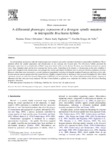Use este identificador para citar ou linkar para este item:
http://www.alice.cnptia.embrapa.br/alice/handle/doc/326808Registro completo de metadados
| Campo DC | Valor | Idioma |
|---|---|---|
| dc.contributor.author | FELISMINO, M. F. | pt_BR |
| dc.contributor.author | PAGLIARINI, M. S. | pt_BR |
| dc.contributor.author | VALLE, C. B. do | pt_BR |
| dc.date.accessioned | 2011-08-02T01:01:28Z | - |
| dc.date.available | 2011-08-02T01:01:28Z | - |
| dc.date.created | 2009-04-02 | pt_BR |
| dc.date.issued | 2008 | pt_BR |
| dc.identifier.citation | Cell Biology International, v. 32, p. 1459-1463, Nov. 2008. Issue 11. | pt_BR |
| dc.identifier.uri | http://www.alice.cnptia.embrapa.br/alice/handle/doc/326808 | pt_BR |
| dc.description | Several mutations are known to alter the normal progression of meiosis and can be correlated with defects in microtubule distribution. The dv mutation affects the spindle organization and chromosomes do not converge into focused poles. Two Brachiaria hybrids presented the phenotypic expressions of dv mutation but exhibited many more details in the second division. Bivalents were distantly positioned and spread over a large metaphase plate and failed to converge into focused poles. Depending on the distance of chromosomes at the poles, telophase I nuclei were elongated or the chromosomes were grouped into various micronuclei of different sizes in each cell. The first cytokinesis occurred. However, when there were micronuclei, a second cytokinesis immediately took place dividing the prophase II meiocytes into three or four cells. In each meiocyte, meiosis progressed to the second division. Slightly elongated nuclei or micronuclei were recorded in telophase II. After a third cytokinesis, hexads or octads were formed. Pollen grains of different sizes were generated. One of these hybrids presented a higher frequency of abnormal cells than when previously analyzed. The fate of these hybrids as genitors or as candidates for cultivars in the Brachiaria breeding program is discussed. | pt_BR |
| dc.language.iso | eng | eng |
| dc.rights | openAccess | eng |
| dc.subject | Braquiária | pt_BR |
| dc.subject | Campo Grande | pt_BR |
| dc.subject | Mato Grosso do Sul | pt_BR |
| dc.subject | Brasil | pt_BR |
| dc.title | A differential phenotypic expression of a divergent spindle mutation in interspecific Brachiaria hybrids. | pt_BR |
| dc.type | Artigo de periódico | pt_BR |
| dc.date.updated | 2011-08-02T01:01:28Z | pt_BR |
| dc.subject.thesagro | Brachiaria | pt_BR |
| dc.subject.thesagro | Citogenética Vegetal | pt_BR |
| dc.subject.thesagro | Gramínea Forrageira | pt_BR |
| dc.subject.thesagro | Hibrido | pt_BR |
| dc.subject.thesagro | Meiose | pt_BR |
| dc.subject.thesagro | Melhoramento Genético Vegetal | pt_BR |
| dc.subject.thesagro | Pastagem | pt_BR |
| riaa.ainfo.id | 326808 | pt_BR |
| riaa.ainfo.lastupdate | 2011-08-01 | pt_BR |
| dc.contributor.institution | Mariana Ferrari Felismino, UEM; Maria Suely Pagliarini, UEM; Cacilda Borges do Valle, CNPGC. | pt_BR |
| Aparece nas coleções: | Artigo em periódico indexado (CNPGC)  | |
Arquivos associados a este item:
| Arquivo | Descrição | Tamanho | Formato | |
|---|---|---|---|---|
| sdarticle.pdf | 339.04 kB | Adobe PDF |  Visualizar/Abrir |









